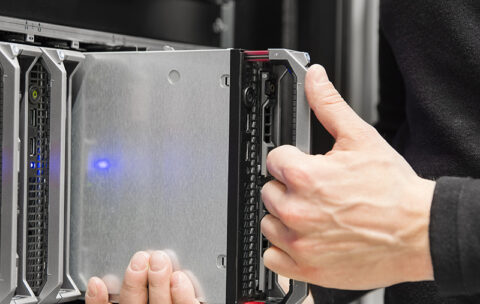Filter by Topic
Filter by Vendor
VMware vSphere: What’s New 6.7 to 7.0
Course Description In this three-day, hands-on training course, you explore …
What you'll learn
Describe the software-defined data center (SDDC)
Explain the vSphere components and their function in the infrastructure
Install and configure ESXi hosts
Deploy and configure VMware vCenter® Server Appliance™
Use VMware vSphere® Client™ to manage the vCenter Server inventory and the vCenter Server configuration
Manage, monitor, back up, and protect vCenter Server Appliance
Create virtual networks with vSphere standard switches
Describe the storage technologies supported by vSphere
Configure virtual storage using iSCSI and NFS storage
Create and manage VMware vSphere® VMFS datastores
Use the vSphere Client to create virtual machines, templates, clones, and snapshots
Create a content library and deploy virtual machines from templates in the library
Manage virtual machine resource use
Migrate virtual machines with VMware vSphere® vMotion® and VMware vSphere® Storage vMotion®
Create and manage a vSphere cluster that is enabled with VMware vSphere® High Availability and VMware vSphere®
Distributed Resource Scheduler™
Discuss solutions for managing the vSphere life cycle
Use VMware vSphere® Lifecycle Manager™ to perform upgrades to ESXi hosts and virtual machines
VMware vSphere: Install, Configure, Manage 7.0
Course Description This course features intensive hands-on training that focuses …
What you'll learn
Describe the software-defined data center (SDDC)
Explain the vSphere components and their function in the infrastructure
Install and configure ESXi hosts
Deploy and configure VMware vCenter® Server Appliance™
Use VMware vSphere® Client™ to manage the vCenter Server inventory and the vCenter Server configuration
Manage, monitor, back up, and protect vCenter Server Appliance
Create virtual networks with vSphere standard switches
Describe the storage technologies supported by vSphere
Configure virtual storage using iSCSI and NFS storage
Create and manage VMware vSphere® VMFS datastores
Use the vSphere Client to create virtual machines, templates, clones, and snapshots
Create a content library and deploy virtual machines from templates in the library
Manage virtual machine resource use
Migrate virtual machines with VMware vSphere® vMotion® and VMware vSphere® Storage vMotion®
Create and manage a vSphere cluster that is enabled with VMware vSphere® High Availability and VMware vSphere® Distributed Resource Scheduler™
Discuss solutions for managing the vSphere life cycle
Use VMware vSphere® Lifecycle Manager™ to perform upgrades to ESXi hosts and virtual machines
VMware vSphere: Fast Track 7.0
Course Description This five-day, intensive course takes you from introductory …
What you'll learn
• Describe the software-defined data center (SDDC)
• Explain the vSphere components and their function in the infrastructure
• Install and configure VMware ESXi™ hosts
• Deploy and configure VMware vCenter® Server Appliance™
• Use VMware vSphere® Client™ to manage the vCenter Server inventory and the vCenter Server configuration
• Manage, monitor, back up, and protect vCenter Server Appliance
• Create virtual networks with vSphere standard switches
• Describe the storage technologies supported by vSphere
• Configure virtual storage using iSCSI and NFS storage
• Create and manage VMware vSphere® VMFS datastores
• Use the vSphere Client to create virtual machines, templates, clones, and snapshots
• Create a content library and deploy virtual machines from templates in the library
• Manage virtual machine resource use and manage resource pools
• Migrate virtual machines with VMware vSphere® vMotion® and VMware vSphere® Storage vMotion®
• Create and manage a vSphere cluster that is enabled with VMware vSphere® High Availability and VMware vSphere®
Distributed Resource Scheduler™
• Create virtual networks with VMware vSphere® Distributed Switch™ and enable distributed switch features
• Discuss solutions for managing the vSphere life cycle
• Use VMware vSphere® Lifecycle Manager™ to perform upgrades to ESXi hosts and virtual machines
• Use host profiles to manage ESXi configuration compliance
• Describe how vSphere storage APIs help storage systems integrate with vSphere
• Configure and use virtual machine storage policies
Tableau Desktop Level 2: Beyond the Basics
Course Description Tableau has emerged as one of the most …
CompTIA A+ Core 1
CompTIA’s A+ certification is the industry standard for validating the …
What you'll learn
Install and configure PC system unit components and peripheral devices.
Install, configure, and troubleshoot display, multimedia devices, storage devices, and internal system components.
Explain network infrastructure concepts.
Configure and troubleshoot network connections.
Implement client virtualization.
Support and troubleshoot laptops, mobile devices and print devices.
CCSP (Certified Cloud Security Professional) Exam Prep | eLearning Bundle
Technology professionals who understand cloud-specific security are in high demand. …
What you'll learn
Understand legal frameworks and guidelines that affect cloud services.
Recognize the fundamentals of data privacy regulatory/legislative mandates
Assess risks, vulnerability, threats, and attacks in the cloud environment.
Evaluate the design and plan for cloud infrastructure security controls.
Evaluate what is necessary to manage security operations.
Understand what operational controls and standards to implement.
Describe the types of cloud deployment models in the types of “as a service” cloud models currently available today.
Identify key terminology, and associated definitions related to cloud technology. Be able to establish a common terminology for use with in your team or workgroup.
Build a business case for cloud adoption and be able to determine with business units the benefits of the cloud and cloud migration strategies.
CISSP (Certified Information Systems Security Professional) Exam Prep
Best CISSP Certification Prep Course Online Overview Passing CISSP requires …
What you'll learn
Understand and apply fundamental concepts and methods related to the fields of information technology and security.
Align overall organizational operational goals with security functions and implementations.
Understand how to protect assets of the organization as they go through their lifecycle.
Understand the concepts, principles, structures, and standards used to design, implement, monitor, and secure operating systems, equipment, networks, applications, and those controls used to enforce various levels of confidentiality, integrity, and availability.
Implement system security through the application of security design principals and the application of appropriate security control mitigations for vulnerabilities present in common information system types and architectures.
Understand the importance of cryptography and the security services it can provide in today’s digital and information age.
Understand the impact of physical security elements on information system security and apply secure design principals to evaluate or recommend appropriate physical security protections.
Understand the elements that comprise communication and network security coupled with a thorough description of how the communication and network systems function.
List the concepts and architecture that define the associated technology and implementation systems and protocols at Open Systems Interconnection (OSI) model layers 1–7.
Identify standard terms for applying physical and logical access controls to environments related to their security practice.
Appraise various access control models to meet business security requirements.
Name primary methods for designing and validating test and audit strategies that support business requirements.
Enhance and optimize an organization’s operational function and capacity by applying and utilizing appropriate security controls and countermeasures.
Recognize risks to an organization’s operational endeavors, and assess specific threats, vulnerabilities, and controls.
Understand the System Lifecycle (SLC) and the Software Development Lifecycle (SDLC) and how to apply security to it, and identify which security control(s) are appropriate for the development environment, and assess the effectiveness of software security.
CISM eLearning
Course Description: Prepare to obtain the Certified Information Security Manager® …
What you'll learn
Establish and/or maintain an information security governance framework and supporting processes to ensure that the information security strategy is aligned with organizational goals and objectives.
Manage information risk to an acceptable level based on risk appetite to meet organizational goals and objectives.
Develop and maintain an information security program that identifies, manages and protects the organization’s assets while aligning to information security strategy and business goals, thereby supporting an effective security posture.
Plan, establish and manage the capability to detect, investigate, respond to and recover from information security incidents to minimize business impact.










